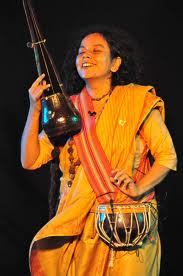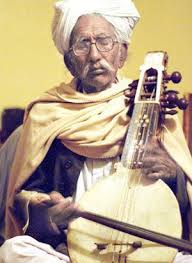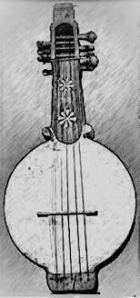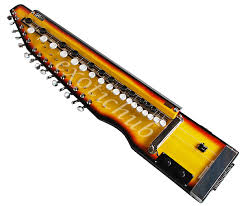Instruments from India — 13/ From the folk & devotional world
Parvathy Baul with the ektara string instrument and duggi percussion instrument, and the late Sakar Khan on the bowed instrument kamaicha
IN September 2012, I had begun a monthly series on Indian musical instruments. The aim was two-fold: one, to make Indian readers aware of certain artistes they might not have heard before, and secondly, to expose relatively new audiences, mainly from the West, to the melodic or rhythmic beauty that various Indian instruments offer.
In this series, I shall not go into too many technicalities and playing styles. I shall focus on how the instrument is used in different genres, and mention the leading performers in each style. However, while I have tried to name all the main musicians, the lists mentioned are by no means exhaustive or complete. In all parts of the series, I shall use a similar format to maintain uniformity, and some portions on the concert structure may be repeated verbatim if needed.
The earlier parts of the series talked about the violin, sitar, bansuri, sarangi, different types of veena, sarod, santoor, shehnai/ nadaswaram, harmonium, Indian adaptations of the guitar, Indian adaptations of other western instruments, and other instruments used in Indian classical music. This month, we feature some instruments that are played in Indian folk and devotional music.
With this, I complete the portion on different types of melody instruments. Next month,I shall conclude this series by talking of combinations of melody instruments that have worked. Then, I shall begin the series ‘Percussion from India’, which shall talk about various drums. This series will start with the extra-popular tabla.
IN this series, I have covered various instruments used in Indian music. These have been used in either Hindustani music of north India, or in the south Indian Carnatic music. Besides the classical styles, these instruments are played in film music, ghazals and fusion.
There are certain instruments, however, that find specific place in Indian folk and devotional music. Many of these are played in select geographical regions, to go along with the local forms of music, and even as an accompaniment to folk dance.
Let’s look at some of these instruments. We shall only talk of melody instruments, and the rare percussion instruments will be featured in the next series. While I have tried to cover various folk instruments from across India, there may be few which I might not have been exposed to. Readers are requested to send details of any such melody instruments,
STRING & BOWED INSTRUMENTS
Ektara: It is a one-stringed instrument most often used in traditional music from Bangladesh, India, Egypt, and Pakistan. It was initially played by wandering bards and minstrels from India and is plucked with one finger. A similar two-stringed and bass instrument is known as dotara.
The ektara is used in traditional Baul music of Bengal, and in Sufi and Punjabi folk music too. At the Ruhaniyat Sufi and mystic music festival organised across India, one has often seen Baul singer Parvathy Baul play the ektara while singing, and using the percussion instrument duggi at the same time.
In Punjabi music, a single-string instrument called the tumbi is used, mainly in bhangra music. It was popularised in the 20th century by folk singer Lal Chand Yamla Jatt.
Other types of ektaras used in east and north east India are the kenda, pena and bana. Among certain tribes of western India, the single-stringed tuntuna or chohokode is used.
Esraj, dilruba and sarinda: The esraj is a string instrument which is only about 200 years old. The dilruba has a similar structure, and both are played with a bow.
The esraj is found in central and east India, particularly in Bengal, where it is used as an accompanying instrument in Rabindra Sangeet. The dilruba is found in the north, mainly in religious and light classical music. It is a derivative of the taus, another folk instrument.
Pandit Ranadhir Ray was known to be a well-known exponent of esraj. The instrument was also played by music director Roshan, and by spiritual guru Sri Chinmoy.
Sitar maestro Pandit Ravi Shankar once played the dilruba in the 1930s, and in south India, Dilruba Shanmugham played it in old film music. A R Rahman also used the instrument in ‘Dil Se’ and ‘Vande Mataram’.
A similar instrument is the sarinda, which is like the sarangi but uses a different kind of bow. It is played in folk music from Rajasthan, Assam and Tripura, besides Baul music. It is primarily used as an accompaniment for folk singers. In Rajasthani folk music, the Sindhi sarangi and ravanhatta are also used.
Sadly, the esraj and dilruba have declined in popularity, almost becoming extinct, and the sarinda is used in limited forms of music.
Kamaicha: It is one of the oldest bowed instruments in the world and is a key presence in Rajasthani folk music. Made from a single piece of wood, the kamaicha consists of a spherical bowl extended into the neck, a fingerboard, and a resonator covered with leather. It usually has four main strings passing over a thin bridge and is played with a bow, producing a haunting melody.
Among kamaicha players, the late Sakar Khan is very well-known. He belonged to the traditional Manganiyar folk musician community of Rajasthan, and had performed with renowned American violinist Yehudi Menuhin and George Harrison of The Beatles, besides appearing in numerous international festivals.
Bulbul tarang: It is an Indian string instrument which evolved from the Japanese taishōgoto, and has been played since the 1930s. It has two sets of strings, one set for drone, and one for melody.
A well-known player is Kapil Sharma, Jazz saxophonist and flautist Henry Threadgill was also fascinated by the instrument, and used it in some recordings.
Rabab: This lute-like instrument originated from Afghanistan, and is similar to the sursingar and sarod. In India, it has been played in Sikh religious music right from Guru Nanak’s time, when Bhai Mardana played it. Among today’s musicians, Chintoo Singh Wasir plays the rabab, besides being known for his guitar.
WIND INSTRUMENTS
Pungi or been: It is a wind instrument played by snake charmers. The ‘been’ is also used in religious and folk music, and by street performers.
The sound of the ‘been’ was reproduced on a keyboard instrument clavioline by Kalyanji in the ‘Nagin’ song ‘Man dole mera tan dole’, composed by Hemant Kumar. The ‘been’ is also used in religious and folk music, and by street performers.
Shankh: The shankh is a conch shell which is blown to create music in devotional music, often to the accompaniment of percussion. The sound created by the shankh is called the shankhnaad, and the instrument is used across India, both in temples and during home poojas.
Algoze: It is a pair of woodwind instruments adopted by Punjabi, Sindhi, Rajasthani and Baloch folk musicians. It resembles a pair of wooden flutes. The musician plays it by using three fingers on each side, and breathing into the flutes.
Kombu: Also known as kombu pattu, it is a wind instrument played in Kerala temple music, accompanied by different percussion instruments. It can only produce three notes — sa, pa and higher sa — but musicians show their dexterity through improvisation. One of the most famous players is Kumath Raman Nair.
Karnal: This is a large, straight brass trumpet, over a metre long, played in parts of north India and Nepal. It is used on ceremonial occasions, such as the processions of village deities.
Another trumpet used in north and east India is the ransingha, which is made of two metal curves, joined together to form an ‘S’ shape.
RARE INSTRUMENTS
Besides these instruments, certain other types are found in different parts of India.
The riwana is a type of fretless lute played in Himachal Pradesh, generally with four strings, and an additional string starting from mid-way down the neck, like the American five-string banjo.
The banam is a class of folk fiddles found among the Santal people of North East India and Bangladesh. The bommbanshi or bombashi is a fipple flute found in Bangladesh, and is also played in Bengal. The kasht tarang is a type of xylophone or marimba used in north India, but is not very common.
India has a rich variety of folk instruments. Unfortunately, many of them are known only in certain states, and that too in specific districts. People from the north are normally unaware of the instruments played in the east and south, unless they happen to travel to these regions and attend folk recitals.
The beauty, however, is that there is so much richness in sounds from across India. While the classical instruments have made inroads across the country, and even abroad, the folk instruments have their own charm that needs to be devoured.















